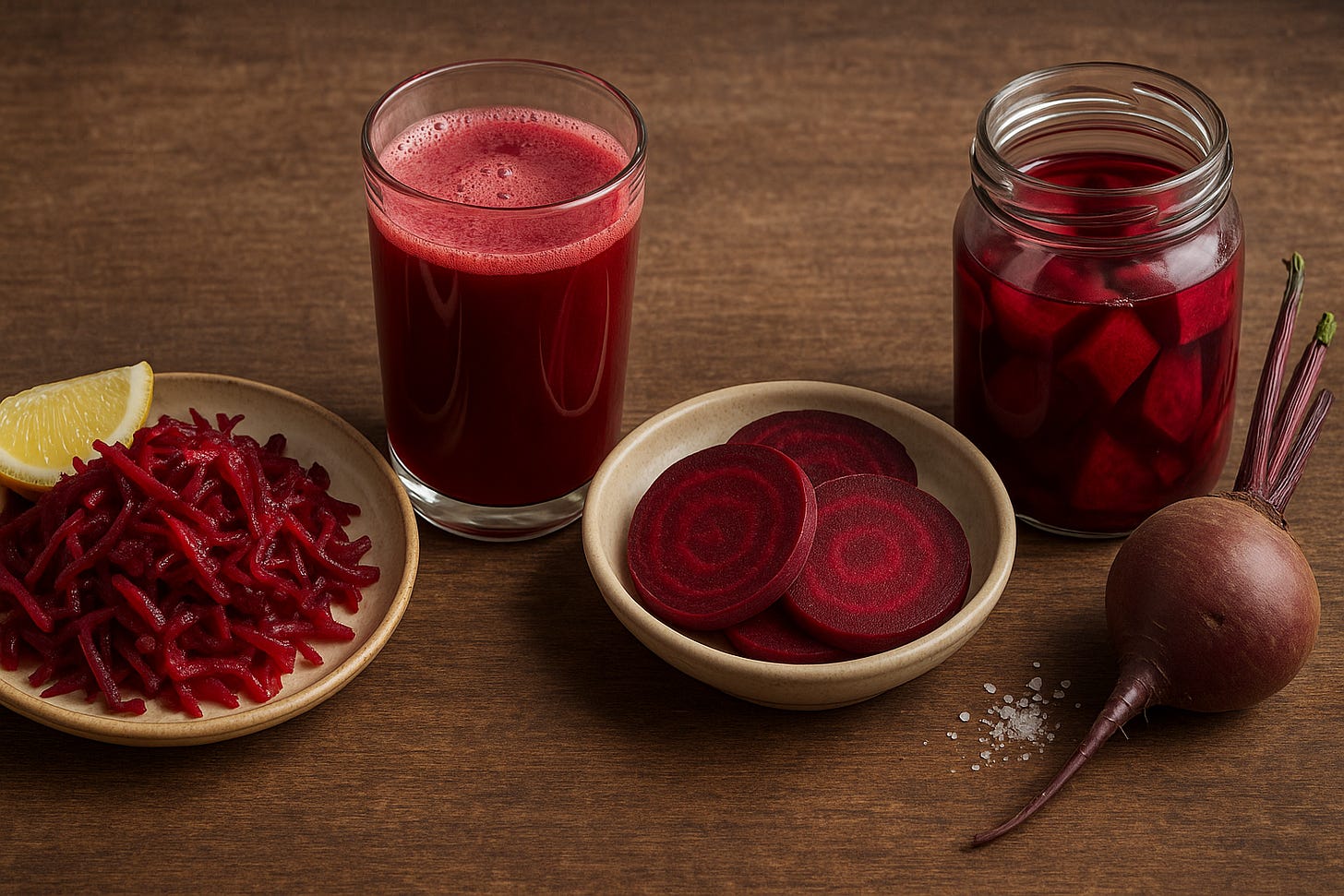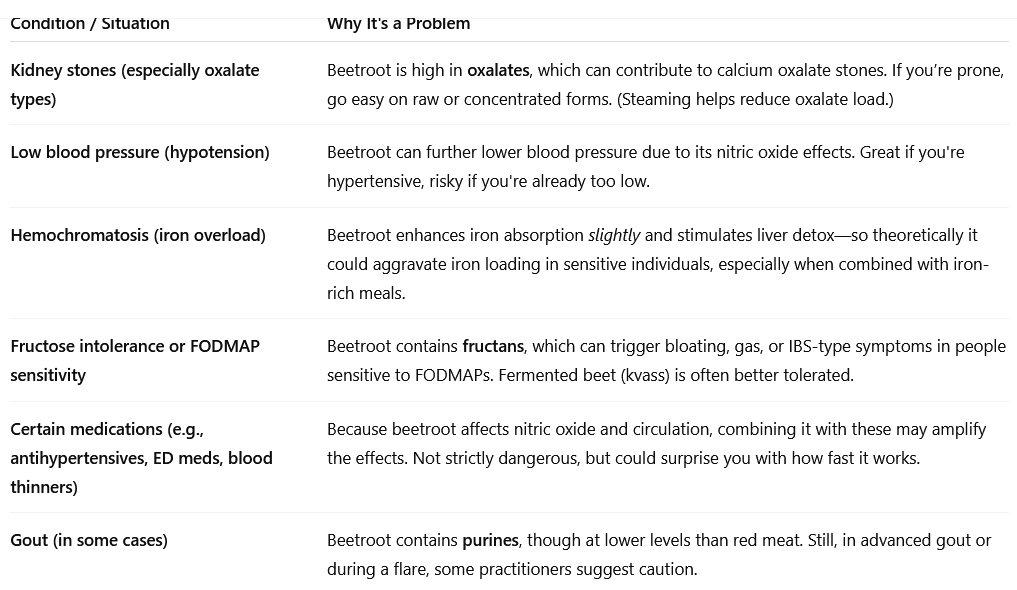The Many Magics of Beetroot: One Root, Four (at least) Rare Medicines
Salad bar relic or healing hero?
Context for this article
A new cosmology
I am building a new cosmology or a new ontology, or however you want to look at it. The old religions carry no relevance to the modern world, and the various reformations into packaged new age belief systems, lack depth and relevance. I personally have no doubt that we are coming to the end of multiple very long eras, so much so, that our next world cannot be represented in the forms and beliefs of this one. This leaves us un-grounded, knowing what is gone is gone, but with no idea what will replace it.
The place of health and healing in this new cosmology
This is particularly relevant when it comes to our health. As many of us know, the various medically names syndromes like Fibromyalgia and Lyme disease, and including the newer ‘long covid’, are marching on, untouched - or maybe just slowed a bit - by any allopathic or wholistic modality. Every traditional healing system is now failing us.
I am bedridden myself, with my legs going on strike in a multitude of ways, and with no medical diagnosis and no treatment. As a result of 23 1/2 hours a day lying down, I have had a lot of thinking time, and in that time I have put together a new system of healing that is essentially kind. The cruel systems are no longer working so maybe a system that prioritises kindness will.
My new motto is:
Healing is not a discipline. It is a remembering of joy.
If whatever you are doing to heal is not pleasurable, it can’t heal.
My journey from inside this new system of healing and health
For 5 months now I have been unable to sit or work at my computer, so I have been using an elaborate system to record and organise my ideas, and a significant book on navigating into our new way of being, is in the making. I have unknowingly been building it for many years, but with my enforced idleness, I finally have the space to know where I was going all that time.
This article results from research I am doing to heal my body of its mysterious illness. Whether a person is healthy and wants to stay that way, or declining and wanting to reverse the decline, amazingly, the humble beetroot offers part of a strategy to do that. This is why.
Beetroot, salad bar relic or healing hero
You could live a lifetime thinking beetroot is just a salad bar relic—dyed eggs, pink hummus, earthy juice shots. But beneath that crimson skin is a quiet pharmacopoeia. Beetroot doesn’t just offer nutrients. It offers biochemical strategies. And depending on how you prepare it, you unlock entirely different modes of action.
I have identified four faces of beetroot. There may be more but there are at least four medicines from one humble, and often very cheap, root. You may not need all of them now, but you never know when you might need help to recover from the next ‘pandemic’ or to simply slow the ageing process.
1. The Hidden Sugars: Five-Carbon Allies
Most of the sugars we eat are six-carbon chains. But inside beetroot live rare five-carbon sugars, ribose, xylulose, and their cousins. These are hidden treasures that quietly support DNA and RNA synthesis, immune function, and cellular repair. These are the architects of structure, the ones who say, ‘Let's rebuild.’
Why we need them:
Modern diets almost never deliver these. They aren’t sweet. They’re subtle. But without them, the scaffolding of regeneration falters. Ribose fuels mitochondrial recovery. Xylulose guides carb metabolism. These sugars operate not as energy, but as infrastructure. We can manufacture them out of six-carbon sugars, but if that capacity breaks down, as it often does, then it is unlikely that we would get enough in our diet with paying attention to consuming the right foods. And beetroot is one of the best.
I will explain five-carbon sugars in more depth in another publication, but if you want to know more, just ask your personal AI.
Best preparation: Raw and slow.
To preserve the five-carbon sugars, avoid heat. Grating raw beetroot and fermenting it as a slaw, or marinating it in lemon and salt, keeps these delicate sugars intact.
Simple Recipe: Raw Beetroot Slaw
1 raw beetroot, peeled and grated
Juice of 1 lemon
A pinch of salt
Optional: splash of olive oil and cracked pepper
Let sit for 10–20 minutes to soften.
2. The Gas That Heals: Nitric Oxide
Beetroot is a nitric oxide factory, but only under certain conditions. This gas relaxes blood vessels, improves oxygen delivery, lowers blood pressure, enhances brain clarity, and helps tissues regenerate. It's a vasodilator and a healer. This may all be particularly relevant to ‘long covid’.
How it works:
Nitrates in beetroot are converted into nitric oxide by oral bacteria and stomach acid, not automatically. That means your method of consumption, and what else is in your mouth, matters.
You can easily test your current nitric oxide levels, by testing your saliva, using readily available nitric oxide test strips.
I will explain nitric oxide in more depth in another publication, but if you want to know more, just ask your personal AI.
Best preparation: Juiced and sipped slowly.
Juicing releases the nitrates. You actually need the woody bits, so make sure you juice the whole thing. Drink it on an empty stomach, ideally after swishing the juice in your mouth (to activate oral bacteria), to make the most of it. Don't brush your teeth right before.
Simple Recipe: Nitric Oxide Beet Juice
1 large beetroot, juiced.
Add a splash of lemon or ginger if you like. I find a decent amount of lemon takes the sickly sweetness of beetroot away.
Sip slowly, swish briefly before swallowing.
3. The Pigment That Protects and Cleans the Liver: Betalains
The deep red-purple color of beetroot comes from betalains, powerful anti-inflammatory pigments that also support methylation and phase 2 liver detox pathways. These are your cleanup crew, clearing cellular mess and reducing oxidative stress. This is particularly important from those with MTHFR genetic variants.
Why it matters:
Betalains help recycle homocysteine into methionine, especially helpful for those with impaired methylation. They're also gentle healers of the liver, asking, not forcing.
Best preparation: Lightly steamed or roasted.
Gentle heat breaks the cell walls just enough to release betalains without degrading them.
Simple Recipe: Steamed Beet Medallions
Slice beets into thick rounds
Steam for 10–15 minutes, until just tender
Serve with olive oil, vinegar, and thyme
4. The Root that Repairs the Liver - Betaine
Beetroot supports the liver in more ways than one. It is also a ‘cholagogue’ (bile stimulant), methyl donor supplier, glutathione booster, and anti-inflammatory. It's not just a detox aid; it's a repair agent.
How it works:
Beetroot’s betaine (a cousin of choline) helps the liver process fats and prevent fatty liver disease. It also supports SAMe production, your master methyl donor.
Best preparation: Beet kvass (fermented).
Fermentation increases the bioavailability of betaine and brings in beneficial probiotics for gut-liver synergy.
Simple Recipe: Beet Kvass
2 medium beets, chopped roughly
1 tsp salt
Fill a jar with filtered water
Let sit at room temperature for 3–5 days, burping daily
Drink 50–100 ml per day as a tonic
I will explain betalains and betaine in more depth in another publication, but if you want to know more, just ask your personal AI.
Beetroot Contraindications (or Caution Zones)
Beetroot is gentle and mostly harmless, but like anything medicinal, it is possible to over-do it. Check out the following table of cautions before you get gung-ho and risk consuming too much.
Other Notes
Pink urine or stools (beeturia) is harmless, but can freak people out.
Nitrate sensitivity is rare, but in people with certain methylation issues or nitrate-converting imbalances, excess beet juice can cause headaches or fatigue instead of helping.
Final Note: One Root, Many Doors
There is no one way to consume beetroot. You don’t need to eat or drink it every day. But when you do, consume it with intention. Each preparation opens a different biochemical door. Some days, you need nitric oxide. Some days, you need liver love. Some days, you just need scaffolding for your bones and nerves.
Beetroot will meet you wherever you are - as gentle on your purse as it is on your body.
If you think others may benefit from my articles and insights
please spread the message by sharing, restacking and subscribing.
If you would like to help me keep going despite my battle with serious ill health…
a PayPal donation will be gratefully received. Please forgive my less well edited writing. I am having to do everything lying down as I am unable to sit, and that is hard going. If you are feeling well supported financially, you might like to help me purchase the IT equipment I need to create this book lying down, and the healing agents I need in my quest to recover.





Thank you so much for your tips on health after the COVID-19 virus, we are both likely to meet in the same place shortly. God bless you Christy you are in my prayers, take care
Do you use an infrared light and methylene blue? I’m actually not intending to give you advice. I just wonder if you use those two things, I use those two things, but I’ve never been in extremely poor health like you are. I guess you can’t move so I was also wondering, if you can do earthing, and if you can go in direct sunlight?And can somebody give you a wheelchair? In the US, people can get wheelchairs from charity stores. Are you stuck without one?